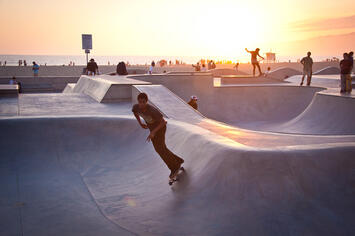
My young daughter was extremely excited when I pulled up to the large, two-level skate park in Riverhead, New York. I have been taking her brother there for many years and, despite her young age and small size, she wanted to take her scooter to the park. Other parents already at the park warned me of tough-looking teens in the lower level of the park and suggested we keep our distance. While the warning was well-intentioned, my daughter did not hear them and took off for the lower level and the ramps. When she made it to the bottom, the older teens moved out of her way, started cheering her on and encouraging here, and then took their turns after my daughter rode down the ramps herself. Over the next half an hour, the older teens were kind and supportive and took a great interest in my daughter, giving her tips and smiling the whole time.
While I would like to say that this was some magical moment at a skate park—it wasn’t. Over the past five years or so, my son and I have visited skate parks around the country, from California and Minnesota to New York and Virginia, and the same narrative always plays out: The people there, and skate culture more generally, may look a little rough, but these parks are incredible examples of third places—public places that are open to all which are not home or a workplace and enable people to mingle and connect on many levels. Open to all and radically inclusive, these are true communal places where many come together to congregate, skate, and develop relationships over time. I have watched scores of older children and adults cheer on and teach my son over the years. The community that develops around skating is authentic, supportive, and very much needed in a world of so much social anomie and digitally intermediated connection.
There has been some popular positive coverage of skate parks such as the 2001 film, Dogtown, and public health work showing that skating helps with physical and mental health—but skate parks and skate culture have a less than stellar reputation. Growing up in Philadelphia in the 1980s, skateboarders certainly had bad status. In addition to being known for effectively taking over public places and plazas—like Dilworth Plaza and the surrounding environs in Center City—the skateboarding culture was perceived to be an activity favored by deviants and people without ambition. Skateboarding has long been associated with gangs and other forms of crime, furthering its unfortunate negative reputation.
Nevertheless, despite particular cases of problems around skating and the fact that it may still represent its counter-cultural roots, skate parks are powerful and positive pieces of civic infrastructure. Cities and communities should invest in these powerful civic third spaces. More municipalities should seriously consider building more parks and spaces for gathering and skating. These parks make, “class, race, gender . . . irrelevant . . . [and are] egalitarian and inclusive.” Girls and women, like my daughter, are a significantly growing proportion of the community.
Read the rest of this piece at AEI.
Samuel J. Abrams is a professor of politics at Sarah Lawrence College and a senior fellow at the American Enterprise Institute.
Photo: Chris Gold via Flickr under CC 2.0 License.












